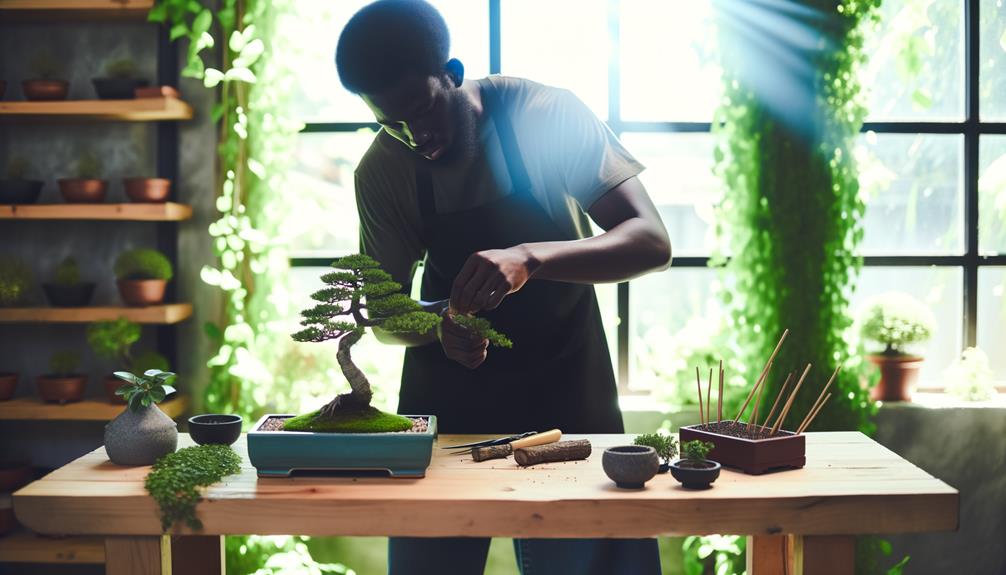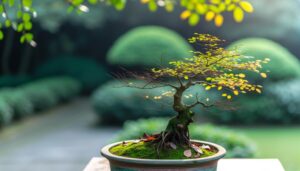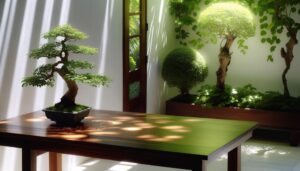Why Do We Keep Bonsai at Home?
Keeping bonsai at home is entirely feasible with accurate maintenance and care. Select species like Ficus, Juniper, or Chinese Elm, considering their specific needs.
Maintain indoor temperatures between 60°F and 75°F and guarantee adequate light, using south-facing windows or grow lights. Proper soil composition, typically a mix of akadama, pumice, and lava rock, is essential for drainage and aeration.
Employ consistent watering techniques and use fertilizers tailored to bonsai requirements. Regular pruning and pest control ensure the plant’s health and aesthetic appeal.
With these detailed practices, your bonsai will thrive, enhancing both air quality and interior beauty. Discover advanced tips on bonsai care further.

1 Key Takeaways
- Bonsai trees can thrive indoors with proper temperature, humidity, light, and air circulation.
- Regular pruning and shaping are essential for maintaining bonsai health and aesthetics.
- Use a well-draining soil mix and water appropriately to avoid root rot.
- Indoor bonsai improve air quality and provide stress relief and mental well-being.
- Ensure adequate light exposure using south-facing windows or full-spectrum grow lights.
2 Choosing the Right Bonsai

Selecting the appropriate bonsai species is a critical initial step that demands a thorough understanding of the tree’s specific climatic, lighting, and care requirements. Knowledge of species such as Ficus, Juniper, or Chinese Elm, each with distinct growth patterns and environmental needs, is essential.
For instance, Ficus is robust and tolerates lower light levels, making it suitable for indoor environments. In contrast, Junipers necessitate high light intensity and cooler temperatures, often thriving better outdoors. Understanding root structure, susceptibility to pests, and water requirements further refines the selection process.
Additionally, consider the bonsai’s potential growth size to guarantee it harmonizes with available space. Expertise in species-specific attributes will secure the long-term health and aesthetic quality of the bonsai, optimizing its integration into home settings.
3 Ideal Indoor Conditions
Once the appropriate bonsai species is selected, creating ideal indoor conditions is essential to guarantee the tree’s health and vitality.
Temperature regulation is paramount; maintain a consistent range between 60°F and 75°F.
Adequate light exposure is necessary, ideally through south-facing windows or supplemental grow lights providing 5,000-6,000 lumens.
Humidity levels should be sustained between 40% and 60%, achievable through misting or humidity trays.
Proper air circulation prevents fungal growth and pest infestations, so make sure the area is well-ventilated.
Soil composition should be well-draining, typically a mix of akadama, pumice, and lava rock.
Regular pruning and repotting every 2-3 years are required to maintain root health.
Attention to these factors will create a thriving environment for your indoor bonsai.
4 Watering Techniques

Proper watering techniques are crucial for maintaining the health and longevity of indoor bonsai trees. The frequency and amount of water required depend on species, pot size, and environmental factors such as humidity and temperature. To determine when to water, insert a chopstick into the soil; if it emerges dry, watering is needed.
Utilize a watering can with a fine nozzle to guarantee even distribution and prevent soil displacement. It is essential to water until excess drains from the pot’s bottom, ensuring complete saturation. Avoid waterlogged conditions by allowing the soil to dry slightly between waterings.
Regularly monitor the moisture level, particularly during seasonal changes, to adjust the watering schedule accordingly. Proper hydration is crucial to bonsai health.
5 Soil and Fertilization
The finest soil composition for bonsai trees must balance aeration, water retention, and drainage to support robust root development. A well-structured soil mix ensures prime nutrient absorption and minimizes root rot risks.
Key components of an ideal bonsai soil mix include:
- Akadama: A hard-baked Japanese clay known for excellent water retention and moderate drainage.
- Pumice: A volcanic byproduct that enhances aeration and facilitates nutrient uptake.
- Lava Rock: Contributes to drainage and provides a stable structure to prevent soil compaction.
- Organic Matter: Typically in the form of compost or bark, it adds nutrients and retains moisture.
Fertilization is critical; balanced, slow-release fertilizers should be applied throughout the growing season, tailored to the specific needs of the bonsai species.
6 Pruning and Shaping

Achieving the desired aesthetic and health of a bonsai tree necessitates meticulous pruning and shaping, which are fundamental techniques that control growth direction, maintain proportion, and enhance the tree’s natural beauty.
Pruning removes unwanted branches, leaves, and roots, ensuring ideal light penetration and air circulation. Techniques such as pinching, thinning, and defoliation are employed to refine branch structure and foliage density.
Shaping, often achieved through wiring, bends and directs branches in desired orientations, creating harmonious and balanced forms. Precision and timing are critical; pruning is typically done during the tree’s dormant phase, while wiring can be applied throughout the year, depending on the species.
Mastery of these techniques results in a miniature yet mature representation of a full-sized tree.
7 Pest and Disease Control
Effective pest and disease control in bonsai cultivation requires an intricate understanding of common pathogens and pests, as well as the implementation of preventive and responsive measures tailored to the unique needs of miniature trees.
Key practices include:
- Regular Inspection: Conduct frequent leaf and soil inspections to detect early signs of infestation or disease, such as discoloration, webbing, or unusual growth patterns.
- Sanitation: Maintain a clean environment by removing fallen leaves and debris from the bonsai pot and surrounding area to prevent pest proliferation.
- Biological Controls: Utilize beneficial insects like ladybugs or predatory mites to naturally manage pest populations without harming the bonsai.
- Chemical Treatments: Apply fungicides or insecticides judiciously, ensuring that they are appropriate for bonsai use and do not damage the delicate root system.
8 Seasonal Care Tips

Seasonal care for bonsai is crucial to maintaining their health and aesthetic appeal, necessitating adjustments in watering frequency, temperature, and humidity control.
Each season brings unique requirements, such as precise pruning and shaping techniques tailored to the tree’s growth cycle.
Mastering these seasonal adjustments guarantees growth and minimizes stress on the bonsai.
Watering Frequency Adjustments
Adjusting the watering frequency for bonsai trees is important to accommodate the varying moisture needs dictated by seasonal changes. Proper hydration management is vital for the health and development of bonsai.
Here are some key points to keep in mind:
- Spring: Increased growth necessitates more frequent watering. Monitor soil moisture levels daily.
- Summer: Higher temperatures and extended daylight hours mean trees will need more water, often requiring multiple daily checks.
- Autumn: Gradual reduction in watering frequency aligns with decreasing temperatures and slower growth rates.
- Winter: Minimal water is needed due to dormancy, but make sure soil does not dry out completely.
Following these seasonal adjustments ensures your bonsai receives the best care needed for thriving year-round.
Temperature And Humidity
Understanding the interplay between temperature and humidity is vital for maintaining the best health of bonsai trees throughout the year. Bonsai trees require a stable environment with temperature and humidity levels that mimic their natural habitats.
During winter, indoor bonsai should be kept away from heating vents and drafty windows to avoid temperature fluctuations. Humidity trays can be used to counteract the drying effects of indoor heating.
Conversely, in summer, proper ventilation is important to prevent overheating and guarantee adequate air circulation. Regular misting can help maintain ideal humidity, especially in drier climates.
Monitoring and adjusting these environmental factors seasonally ensures that bonsai trees experience minimal stress and thrive in their indoor settings.
Pruning And Shaping
Maintaining ideal temperature and humidity is fundamental, but equally important is the meticulous practice of pruning and shaping, which must be adjusted seasonally to promote healthy growth and aesthetic form in bonsai trees.
The following seasonal care tips are pivotal:
- Spring: Engage in structural pruning to remove unwanted branches and enhance airflow. This is the period of vigorous growth.
- Summer: Perform maintenance pruning to manage new growth and maintain the desired shape, ensuring that excessive foliage does not stress the tree.
- Autumn: Focus on thinning out dense areas to prepare the tree for dormancy, preserving its structural integrity.
- Winter: Limit pruning activities; concentrate on wiring for shaping, as the tree is in a dormant phase and more pliable for structural adjustments.
9 Benefits of Indoor Bonsai
Cultivating bonsai indoors offers numerous benefits, including improved air quality, stress reduction, and enhanced aesthetic appeal, making it a valuable addition to any home environment.
The process of photosynthesis in bonsai trees helps to filter and purify indoor air by absorbing carbon dioxide and releasing oxygen.
Moreover, the presence of indoor bonsai can have a calming effect, reducing stress and promoting mental well-being through biophilic design principles.
The meticulous care required for bonsai cultivation can also serve as a meditative practice, fostering mindfulness.
Also, the intricate and artistic nature of bonsai adds a unique visual element to interior spaces, enhancing their aesthetic qualities and contributing to a more harmonious living environment.
10 Common Mistakes to Avoid

When cultivating bonsai at home, it is essential to circumvent common pitfalls such as overwatering, improper light exposure, and neglecting regular pruning.
Overwatering can lead to root rot, compromising the plant’s health, while insufficient or excessive light can impede photosynthesis and growth.
Additionally, regular pruning is necessary to maintain the tree’s aesthetic shape and structural integrity.
Overwatering Your Bonsai
One of the most crucial errors in bonsai care is overwatering, which can lead to root rot and other harmful conditions for the plant. Overwatering disrupts the delicate balance of moisture and oxygen in the soil, essential for the root system’s health.
To avoid this, consider the following guidelines:
- Soil Composition: Use well-draining soil to prevent water retention.
- Watering Frequency: Water only when the top inch of soil feels dry to the touch.
- Pot Selection: Ensure pots have adequate drainage holes to facilitate excess water escape.
- Seasonal Adjustments: Adjust watering schedules based on seasonal changes, as bonsai require less water during dormant periods.
Incorrect Light Exposure
Improper light exposure is a common pitfall in bonsai cultivation, often leading to weakened growth and susceptibility to diseases.
Bonsai trees require precise photoperiods to simulate natural conditions, which vary between species. Insufficient light can cause etiolation, characterized by elongated stems and sparse foliage. Conversely, excessive light can result in leaf burn and dehydration.
To optimize light exposure, one must consider light intensity, duration, and quality. Utilizing grow lights with full-spectrum bulbs can mimic natural sunlight and guarantee balanced growth. Positioning the bonsai near windows with filtered light can also be effective.
Regularly rotating the tree helps in even light distribution, preventing asymmetric growth. Monitoring these factors is essential for maintaining a healthy bonsai.
Neglecting Regular Pruning
While optimizing light exposure is crucial for bonsai health, neglecting regular pruning can equally undermine the structural integrity and aesthetic balance of these miniature trees. Proper maintenance involves systematic trimming to encourage growth patterns that are both healthy and visually appealing.
Here are four key reasons why regular pruning is essential:
- Control Growth: Pruning helps manage the size and shape of the bonsai, preventing it from becoming overgrown.
- Enhance Health: Removing dead or diseased branches improves overall plant vitality.
- Promote Aesthetics: Regular trimming maintains the desired artistic form and symmetry.
- Encourage Foliage Density: Pruning stimulates the development of denser foliage, contributing to a lush appearance.
Neglecting these practices can lead to an unkempt, unhealthy bonsai.
11 Conclusion
The cultivation of bonsai indoors requires meticulous attention to selecting the appropriate species, optimizing environmental conditions, and implementing precise care techniques.
By adhering to rigorous watering schedules, soil management, and pruning practices, one can maintain the health and aesthetics of these miniature trees.
What better way to enhance indoor spaces than by integrating these living works of art?
Mastery of bonsai care not only offers aesthetic pleasure but also fosters a deeper connection with horticultural practices.





